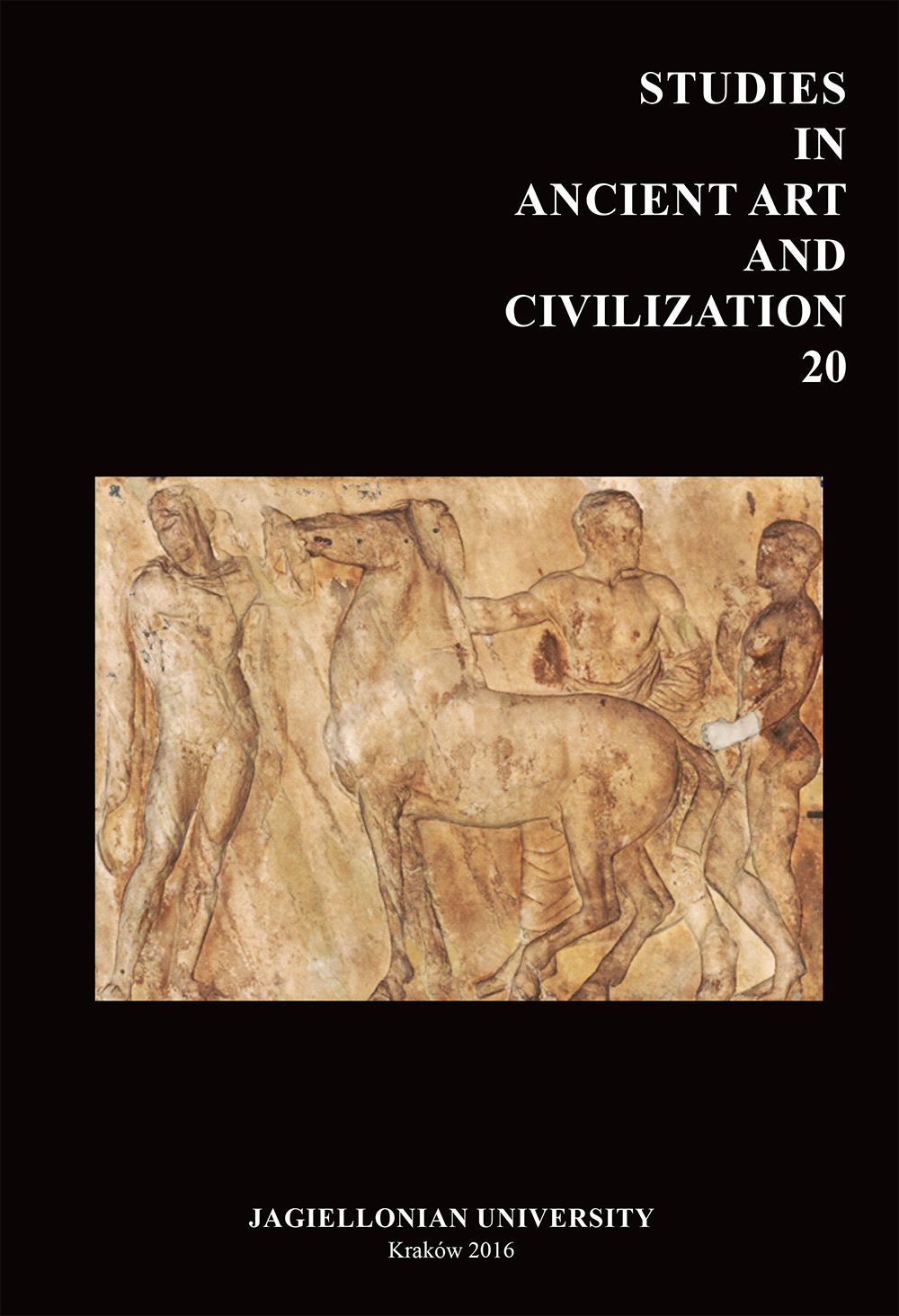A Bronze Steelyard with an Acorn-Shaped Counterweight from the Paphos Agora
DOI:
https://doi.org/10.12797/SAAC.20.2016.20.09Keywords:
steelyard, acorn-shaped counterweight, Cypriot pound, Paphian pound, weighing systemsAbstract
Steelyards were commonly used by sellers at agorae and fora during the Roman and Byzantine periods. They are based on the principle of the lever, mentioned by Aristotle and probably well-known even earlier. One steelyard made of bronze has been found, together with an acorn-shaped counterweight, at the agora of Nea Paphos during an excavation conducted by the Department of Classical Archaeology, Institute of Archaeology, Jagiellonian University. Also preserved were fragments of chain and two hooks that were used to hang the weighted objects, as well as fragment of a third hook. The device represents the Pompeian type of steelyard and can be dated by analogy to other examples from the 1st century AD. The Paphos balance may be evidence of the use of a local island weighting system based on an operating unit other than the Roman pound (libra).
References
Ballance M., Boardman J., Corbett S. and Hood S. 1989. Excavations in Chios 1952–1955: Byzantine emporio. BSA. Supplementary Volumes 20, 1–145.
BM Guide 1920. Guide to the Exhibition Illustrating Greek and Roman Life. London.
Burnett R. D. and Curtis J. E. 1973. A review of Acquisitions 1963–70 of Western Asiatic Antiquities (2). BMQ 37/3–4, 119–137. DOI: https://doi.org/10.2307/4423134
Corti C. 2001. Balance e stadere. In C. Corti and N. Giordani (eds.), Pondera. Pesi e misure nell’ antichità, 179–190. Modena.
Franken N. 1993. Zur Typologie der antiken Schnellwaage. BJb 193, 69–120. DOI: https://doi.org/10.1007/978-3-322-95914-0_11
Higgins R. 1980. Greek and Roman Jewellery. London.
Hill D. K. 1952. When Romans went shopping. Archaeology 5/1, 51–55.
Karydas N. 1998. Χάλκινος καμπάνος (καντάρι) από παλαιοχριστιανική ἐπαυλή της Θεσσαλονίκης / A bronze steelyard from an early Christian villa in Thessaloniki. Μουσείο Βυζαντινού Πολιτισμού / Museum of Byzantine Culture 5, 36–49.
Megaw A. H. S. 1957. Archaeology in Cyprus, 1957. AR 4, 43–50. DOI: https://doi.org/10.2307/581148
Michon E. 1918. S.v. Libra. In Dictionnaire des antiquités grecques et romaines 3/2, col. 1222–1231. Paris.
Museo Archeologico Nazionale 2014. Steelyard with two arms. Museo Archeologico Nazionale. Retrieved from http://cir.campania.beniculturali.it/museoarcheologiconazionale/thematic-views/imagegallery/RA135/?searchterm=steelyard (status as of Oct., 20th 2015).
Myres J. L. and Ohnefalsch-Richter M. 1899. A Catalogue of the Cyprus Museum. Oxford.
Overbeck J. 1884. Pompeji in seinen Gebäuden, Alterthümern und Kunstwerken. Leipzig.
Papuci-Władyka E. and Machowski W. 2016. Paphos Agora Project. Preliminary results of the 2011–2012 seasons of the Jagiellonian University (Krakow, Poland) excavations. In C. Balandier (ed.), Nea Paphos. Fondation et développement urbanistique d’une ville chypriote de l’antiquité à nos jours. Études archéologiques, historiques et patrimoniales, Actes du Ier colloque international sur Paphos, Avignon, 30, 31 octobre et 1er novembre 2012, organisé par Université d’Avignon et des Pays de Vaucluse & Department of Antiquities of Cyprus, 67–77. (Ausonius Éditions, Mémoires 43). Bordeaux.
Papuci-Władyka E., Machowski W. and Miszk Ł. in collaboration with M. Biborski, J. Bodzek, A. Dobosz, M. Droste, M. Kajzer, E. Marzec, K. Nocoń, K. Rosińska-Balik and M. Wacławik forthcoming. Paphos Agora Project (PAP) 2011–2014: First preliminary report on excavations by the Jagiellonian University in Krakow, Poland (with Appendix 1: Preliminary observations on animal remains from Krakow University excavations at the agora of Nea Paphos by P. Croft). RDAC (New Series).
Qedar S. 2001. Weights of Eretz Israel in the Roman-Byzantine period. In O. Rimon and R. Shchori (eds.), Measuring and Weighing in Ancient Times, 23–27. Haifa.
Quaranta B. 1832. Stadere di bronzo. Real Museo Borbonico 8, Tav. XVI.
Richardson Jr. L. 1988. Pompeii: the Casa dei Dioscuri and its painters. MAAR 23/1, 165. DOI: https://doi.org/10.2307/4238635
Richter G. M. A. 1915. Greek, Roman and Etruscan Bronzes. New York.
Richter G. M. A. 1924. Greek and Roman bronzes: recent acquisitions. BMMA 19/3, 68–72. DOI: https://doi.org/10.2307/3254937
Smith S. 1938. Old Babylonian bronzes. BMQ 12/4, 138–140. DOI: https://doi.org/10.2307/4422102
Tarbell F. B. 1909. Catalogue of bronzes, etc. in Field Museum of Natural History. Field Museum of Natural History 130. Anthropological Series 7/3, 93–144.
Twardecki A. forthcoming. A lead weight with agoranomos Seleukos name from the Jagiellonian University excavations at Paphos Agora.
Wacławik M. 2015. The symbolic meaning of the acorn – a possible interpretation. SAAC 19, 255–265.
Wacławik M. 2016a. Looking for a lost weight. In M. Kajzer, Ł. Miszk and M. Wacławik (eds.), The Land of Fertility 1. South-East of Mediterranean since the Bronze Age to the Muslim Conquest, 117–121. Cambridge.
Wacławik M. 2016b. Bronze steelyards from the Studium Biblicum Franciscanum Jerusalem Archaeological Museum. Liber Annuus 66, 219–225. DOI: https://doi.org/10.1484/J.LA.4.2018017
Yates J. 1875. S.v. Trutina. In A Dictionary of Greek and Roman Antiquities, 1170. London.
Zahn R. 1913. Zwei neue Schnellwagen im Antiquarium. AmtlBer 35/1, 1–10.
Downloads
Published
Issue
Section
How to Cite
Funding data
-
Narodowym Centrum Nauki
Grant numbers 2011/01/B/HS3/01282;2014/14/A/HS3/00283;2014/15/N/HS3/0136






